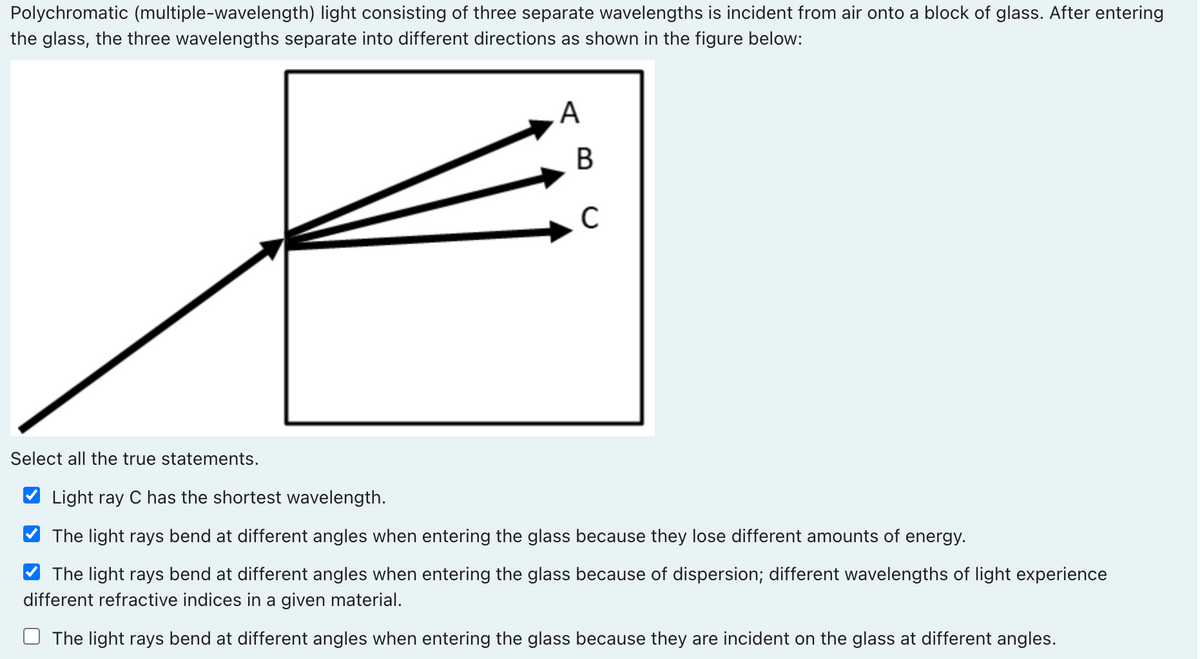Polychromatic (multiple-wavelength) light consisting of three separate wavelengths is incident from air onto a block of glass. After entering the glass, the three wavelengths separate into different directions as shown in the figure below: В Select all the true statements. V Light ray C has the shortest wavelength. The light rays bend at different angles when entering the glass because they lose different amounts of energy. V The light rays bend at different angles when entering the glass because of dispersion; different wavelengths of light experience different refractive indices in a given material. O The light rays bend at different angles when entering the glass because they are incident on the glass at different angles.
Polychromatic (multiple-wavelength) light consisting of three separate wavelengths is incident from air onto a block of glass. After entering the glass, the three wavelengths separate into different directions as shown in the figure below: В Select all the true statements. V Light ray C has the shortest wavelength. The light rays bend at different angles when entering the glass because they lose different amounts of energy. V The light rays bend at different angles when entering the glass because of dispersion; different wavelengths of light experience different refractive indices in a given material. O The light rays bend at different angles when entering the glass because they are incident on the glass at different angles.
Physics for Scientists and Engineers: Foundations and Connections
1st Edition
ISBN:9781133939146
Author:Katz, Debora M.
Publisher:Katz, Debora M.
Chapter38: Refraction And Images Formed By Refraction
Section: Chapter Questions
Problem 29PQ: The wavelength of light changes when it passes from one medium into another. Suppose green light at...
Related questions
Question
more than one answer can be correct

Transcribed Image Text:Polychromatic (multiple-wavelength) light consisting of three separate wavelengths is incident from air onto a block of glass. After entering
the glass, the three wavelengths separate into different directions as shown in the figure below:
В
Select all the true statements.
Light ray C has the shortest wavelength.
The light rays bend at different angles when entering the glass because they lose different amounts of energy.
The light rays bend at different angles when entering the glass because of dispersion; different wavelengths of light experience
different refractive indices in a given material.
The light rays bend at different angles when entering the glass because they are incident on the glass at different angles.
Expert Solution
This question has been solved!
Explore an expertly crafted, step-by-step solution for a thorough understanding of key concepts.
Step by step
Solved in 2 steps with 2 images

Knowledge Booster
Learn more about
Need a deep-dive on the concept behind this application? Look no further. Learn more about this topic, physics and related others by exploring similar questions and additional content below.Recommended textbooks for you

Physics for Scientists and Engineers: Foundations…
Physics
ISBN:
9781133939146
Author:
Katz, Debora M.
Publisher:
Cengage Learning

Physics for Scientists and Engineers: Foundations…
Physics
ISBN:
9781133939146
Author:
Katz, Debora M.
Publisher:
Cengage Learning